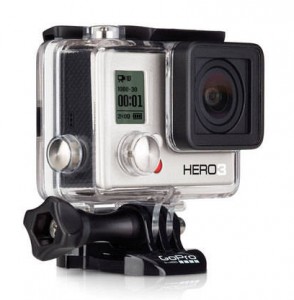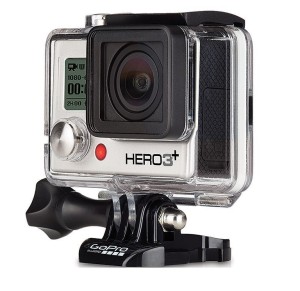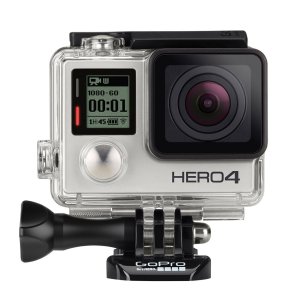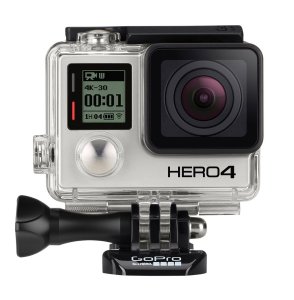A few years ago, once you’d decided to take the plunge and get a GoPro, there was really only one model available (at least if you wanted the latest model) and so the choice was simple. Then, with the introduction of the GoPro Hero 3 in October 2012 (and subsequently the Hero 3+ models in 2013), there were three parallel models to chose between – White, Silver and Black. Now, since October 2014, GoPro has really moved things on, adding two new cameras at the top of the range, and another new camera at the bottom, which together ‘bookend’ three of the existing Hero 3 and 3+ models. Confused? Don’t worry – we’re here to help you navigate through the various options, work out which features really matter to you, and what all that means for what camera you should buy!
So, here is a quick overview of the current GoPro range (as it has been from 5 October 2014) – from bottom to top we have:
- The GoPro Hero – NEW – this is the new entry-level GoPro – the same video specs as the Hero 3 White (1080p at 30fps maximum resolution) and some exciting extra features (discussed further below) but no wifi connectivity – priced around $130
- The GoPro Hero 3 White – carried over from the previous range – 1080p at 30fps maximum resolution, and wifi connectivity allowing use with the GoPro smartphone app and remote control – priced around $200
- The GoPro Hero 3+ Silver – also carried over from the previous range – 1080p at 60fps maximum resolution, plus wifi connectivity – priced around $300
- GoPro Hero 4 Silver – NEW – the first GoPro to feature a built-in touch sensitive display. 4K at 15fps, 2.7K at 30fps and 1080P at 60fps; wifi connectivity and some additional new features – priced around $400
- The GoPro Hero 4 Black – NEW – this is the big daddy of the range – no screen, but a doubling of the video specs over the previous Hero 3+ Black – maximum resolution now 4K at 30fps, with 1080p at 120fps – priced around $500
So, three wholly new cameras, two existing cameras, and a price point rising from $130 to $500. Which one to go for?!
GoPro Hero
 Starting at the bottom of the range, the new GoPro Hero can shoot at 1080p at 30fps and 720p at either 30 or 60fps. Interestingly, this base GoPro Hero also gets the SuperView mode (explained further here) which was previously a feature only on the Hero 3+ Black, and even now is only included on the Hero 4 cameras, not the residual Hero 3 White and 3+ Silver models. It also features an auto low light mode and a new “QuikCapture” setting for one touch operation – again both features on the new Hero 4 but not on the Hero 3/3+) As for still photos, it can shoot five 5MP stills per second. On the downside, the Hero does not feature wifi, so cannot be used with GoPro’s smartphone app for reviewing footage or adjusting settings, or with the optional wifi remote control. In addition, the Hero has a different approach to its case design to the other GoPros – the camera is built directly into the housing, and cannot be removed. The main impact of this is that the battery is also built-in and non-removable, so there is no ability to swap out a drained battery for a fresh one. We’ve written up a detailed comparison of the new GoPro Hero against the GoPro Hero 3 White, which you can find here.
Starting at the bottom of the range, the new GoPro Hero can shoot at 1080p at 30fps and 720p at either 30 or 60fps. Interestingly, this base GoPro Hero also gets the SuperView mode (explained further here) which was previously a feature only on the Hero 3+ Black, and even now is only included on the Hero 4 cameras, not the residual Hero 3 White and 3+ Silver models. It also features an auto low light mode and a new “QuikCapture” setting for one touch operation – again both features on the new Hero 4 but not on the Hero 3/3+) As for still photos, it can shoot five 5MP stills per second. On the downside, the Hero does not feature wifi, so cannot be used with GoPro’s smartphone app for reviewing footage or adjusting settings, or with the optional wifi remote control. In addition, the Hero has a different approach to its case design to the other GoPros – the camera is built directly into the housing, and cannot be removed. The main impact of this is that the battery is also built-in and non-removable, so there is no ability to swap out a drained battery for a fresh one. We’ve written up a detailed comparison of the new GoPro Hero against the GoPro Hero 3 White, which you can find here.
GoPro Hero 3 White
 Moving up the range, the GoPro Hero 3 White Edition can also shoot at 1080p at 30fps, 960p also at 30fps (4:3 format) and 720p at either 30 or 60fps. However, as it is essentially a camera from the previous Hero 3 range, it does not feature the SuperView mode, or the QuikCapture setting. On the still photo side, it shoots three 5MP stills per second – so a drop from the five per second on the new GoPro Hero. However, making up for the slight decrease in video and photo features in comparison to the GoPro Hero (and presumably amounting to the $70 price premium), the Hero 3 White features built-in wifi, allowing it to be used with the GoPro smartphone app, and the optional remote control, and the battery can be swapped out for a spare while on the go.
Moving up the range, the GoPro Hero 3 White Edition can also shoot at 1080p at 30fps, 960p also at 30fps (4:3 format) and 720p at either 30 or 60fps. However, as it is essentially a camera from the previous Hero 3 range, it does not feature the SuperView mode, or the QuikCapture setting. On the still photo side, it shoots three 5MP stills per second – so a drop from the five per second on the new GoPro Hero. However, making up for the slight decrease in video and photo features in comparison to the GoPro Hero (and presumably amounting to the $70 price premium), the Hero 3 White features built-in wifi, allowing it to be used with the GoPro smartphone app, and the optional remote control, and the battery can be swapped out for a spare while on the go.
GoPro Hero 3+ Silver
 Next in the revised line up is the GoPro Hero 3+ Silver Edition, also a carry over from last year’s cameras. This model adds a number of different framerates and fields of view to the 1080p, 960p and 720p modes. Notably, the 1080p resolution gains a 60fps setting, while 120fps is available at 720p resolution. On the still photo side, the Silver can manage a burst of ten 11MP shots in a second, and also has the ability to set the resolution to either 11MP, 7MP or 5MP. The 3+ Silver features wifi connectivity, but again, as one of last year’s models in doesn’t have some of the new features found on the GoPro 4 and Hero models, or the SuperView mode (which was previously the preserve of the range topping Hero 3+ Black).
Next in the revised line up is the GoPro Hero 3+ Silver Edition, also a carry over from last year’s cameras. This model adds a number of different framerates and fields of view to the 1080p, 960p and 720p modes. Notably, the 1080p resolution gains a 60fps setting, while 120fps is available at 720p resolution. On the still photo side, the Silver can manage a burst of ten 11MP shots in a second, and also has the ability to set the resolution to either 11MP, 7MP or 5MP. The 3+ Silver features wifi connectivity, but again, as one of last year’s models in doesn’t have some of the new features found on the GoPro 4 and Hero models, or the SuperView mode (which was previously the preserve of the range topping Hero 3+ Black).
GoPro Hero 4 – Silver and Black
Then we come to the newly introduced GoPro 4 models. Here, GoPro have taken an interesting approach – effectively, what we see is the flagship GoPro Hero 4 Black edition becoming increasingly a prosumer / professional spec camera, while the GoPro Hero 4 Silver is aimed more squarely at consumers with its built-in touch screen.
Both the GoPro Hero 4 models feature a range of new features above and beyond those found on the previous 3 and 3+ models:
- A dedicated ‘HiLight’ button on the lower right side of the camera, which can be used to tag key moments in the footage as they occur, so that they can be located later during editing
- An addition button on the front display of the camera to simplify the settings menu access
- An automatic low light mode, which can change the framerate to adapt to low light conditions (also on the GoPro Hero)
- Night Photo and Night Lapse modes which enable long exposures to be captured
- QuikCapture one touch operation (also on the GoPro Hero)
- Improved audio capture over the Hero 3+ models
The GoPro Hero 4 models also both feature GoPro’s professional Protune mode for both video and photos – this was previously only available on the Hero 3+ Black edition, and allows greater control over white balance and exposure for those who are going to spend considerable timing editing their footage. Like the GoPro Hero, they also both have the SuperView mode – again, previously only found in the 3+ Black edition. As with the 3 and 3+ models (but unlike the Hero) the GoPro Hero 4 cameras also features wifi connectivity so can be used with the app and the remote control.
GoPro Hero 4 Silver
 Looking in detail at the GoPro 4 Silver first, this camera effectively has the same video resolution specifications as the (now discontinued) Hero 3+ Black), but with the addition of a built-in touch screen – a first for GoPro. This means that the Hero 4 Silver has a maximum resolution of 4K at 15fps, stepping up to 30fps at 2.7K, 60fps at 1080p and 120fps at 720p. As such, while it can shoot at higher-than-HD resolutions, the framerate at full 4K is limited to 15fps, which does present a problem for capturing smooth footage.
Looking in detail at the GoPro 4 Silver first, this camera effectively has the same video resolution specifications as the (now discontinued) Hero 3+ Black), but with the addition of a built-in touch screen – a first for GoPro. This means that the Hero 4 Silver has a maximum resolution of 4K at 15fps, stepping up to 30fps at 2.7K, 60fps at 1080p and 120fps at 720p. As such, while it can shoot at higher-than-HD resolutions, the framerate at full 4K is limited to 15fps, which does present a problem for capturing smooth footage.
The big news is the built-in touch LCD – this replicates the functionality previously found on the LCD Touch BacPac, and allows both a live view when shooting, and also the review of previously taken footage. It also facilitates much easier access to the GoPro’s
 setup menus. Amazingly, the Hero 4 Silver is the same depth as the other cameras, and therefore noticeably slimmer than a GoPro with an LCD Touch BacPac attached. The Hero 4 Silver ships with three different backdoors – a fully waterproof option through which the touch screen cannot be controlled; a touch backdoor which is waterproof only to 3m, but through which the touch screen can be controlled, and a skeleton backdoor which leaves the screen fully exposed. On the still photo side, the Hero 4 Silver can shoot 12MP images at an impressive 30 shots per second.
setup menus. Amazingly, the Hero 4 Silver is the same depth as the other cameras, and therefore noticeably slimmer than a GoPro with an LCD Touch BacPac attached. The Hero 4 Silver ships with three different backdoors – a fully waterproof option through which the touch screen cannot be controlled; a touch backdoor which is waterproof only to 3m, but through which the touch screen can be controlled, and a skeleton backdoor which leaves the screen fully exposed. On the still photo side, the Hero 4 Silver can shoot 12MP images at an impressive 30 shots per second.
GoPro Hero 4 Black
 The GoPro Hero 4 Blackis the new range-topper. This camera is being described as having “true 4K” video capture, an acknowledgment that the 15fps at 4K offered by the Hero 4 Silver and the previous Hero 3+ Black is not really quick enough to produce smooth video. With the Hero 4 Black though, the framerates have taken a step up all across the board – so we see 30fps at 4K, 60fps at 2.7K and 120fps at 1080p. In addition, since a firmware updated in February 2015, the Black can now shoot 240fps at 720p, allowing footage to be slowed down by a factor of eight. The Hero 4 Black also comes with all the new Hero 4 features set out above, but without the built-in LCD touchscreen – though you can still add one if you like by buying the LCD Touch BacPac.
The GoPro Hero 4 Blackis the new range-topper. This camera is being described as having “true 4K” video capture, an acknowledgment that the 15fps at 4K offered by the Hero 4 Silver and the previous Hero 3+ Black is not really quick enough to produce smooth video. With the Hero 4 Black though, the framerates have taken a step up all across the board – so we see 30fps at 4K, 60fps at 2.7K and 120fps at 1080p. In addition, since a firmware updated in February 2015, the Black can now shoot 240fps at 720p, allowing footage to be slowed down by a factor of eight. The Hero 4 Black also comes with all the new Hero 4 features set out above, but without the built-in LCD touchscreen – though you can still add one if you like by buying the LCD Touch BacPac.
We’ve set out our full in-depth comparison of the Hero 4 Silver and Black here.
Which GoPro to buy?
So those are all the facts and figures, but the million dollar question (or at least, the $130 – $500 question!) is which of the new GoPro Hero cameras should you buy? Which will best suits your needs and will let you get the footage you want without blowing the budget?
For a lot of users, the new GoPro Hero is likely to provide all the action cam they really need at a very attractive price point. With 1080p at 30fps, and 720p at 60fps, there is scope to both capture smooth full HD footage and, at 720p, to slow down the action by a factor of two during the editing to create a slow-motion effect. The entry level Hero also boasts the SuperView functionality that, until now, was previously only found on the range-topping Black edition (and is still not present on the carried over Hero 3 White and Hero 3+ Silver), and its still photo capabilities are higher than those of the Hero 3 White. The only feature missing from the GoPro Hero is the wifi connectivity. This does mean that users have to forgo the use of the GoPro smartphone app, which provides a very useful way of changing the settings and reviewing footage directly from the camera. Probably of less concern is the inability to use the GoPro remote, since this alone costs nearly half as much as the Hero camera itself. Ultimately, we predict that a lot of people are going to love the ability to get a GoPro for a very decent price, and this might see a lot of new users getting a GoPro for a first time, and others looking to buy and use more than one camera simultaneously in order to a capture footage from several different angles at once.
Moving up to the GoPro Hero 3 White, this now looks like it falls slightly into that gap between the entry level Hero and the Hero 3+ Silver, having as it now does inferior photo specs to both, with its only advantage over the Hero model being its wifi connectivity. If not having wifi is a real deal breaker and you can’t stretch to the 3+ Silver then the White could provide a good option, but in our view, most users would be advised to either put up with the lack of wifi and get the Hero, or see if they can save a little more to get the 3+ Silver…
… Which brings us neatly on to that camera. The GoPro Hero 3+ Silver was previously, in our view, the sweet spot of the range, with 1080p at 60fps and 720p at 120fps providing great, usable options for slow motion at both HD resolutions, and without the distractions, cost and battery life penalty of stepping up to a camera providing a 4K video resolution. That view still stands, and for around $300 the Silver remains an excellent option for those who want higher video specs than those offered by the Hero and the White models.
However, the introduction of the Hero 4 Silver, which has the new Hero 4 features outlined above (particularly SuperView and Protune), the ability to shoot at 4K and 2.7K and a built-in touch screen for  around $100 more than the Hero 3+ Silver, is likely to present something of a dilemma for purchasers. Clearly, if you were thinking of purchasing an LCD Touch BacPac at some stage for a Hero 3+, then it makes more sense to go straight for the Hero 4 Silver, and take the benefit of all the additional new features. Even if you would likely have made do without buying BacPac, the touchscreen does make setting up and operating the camera a great deal easier, and also allows it to be operated more like a traditional video camera. The new Hero 4 Silver also significantly improves the still photo burst ability – 12MP photos at a blistering 30 shots per second, vs 10MP at 10 shots per second on the Hero 3+ Silver. On the other hand, while GoPro has not yet released any figures, the addition of a touchscreen is likely to have a negative impact on battery life. It cannot be denied though that the Hero 4 Silver is a very appealing all-round package, and we can see this perhaps being GoPro’s biggest seller alongside the new entry level Hero.
around $100 more than the Hero 3+ Silver, is likely to present something of a dilemma for purchasers. Clearly, if you were thinking of purchasing an LCD Touch BacPac at some stage for a Hero 3+, then it makes more sense to go straight for the Hero 4 Silver, and take the benefit of all the additional new features. Even if you would likely have made do without buying BacPac, the touchscreen does make setting up and operating the camera a great deal easier, and also allows it to be operated more like a traditional video camera. The new Hero 4 Silver also significantly improves the still photo burst ability – 12MP photos at a blistering 30 shots per second, vs 10MP at 10 shots per second on the Hero 3+ Silver. On the other hand, while GoPro has not yet released any figures, the addition of a touchscreen is likely to have a negative impact on battery life. It cannot be denied though that the Hero 4 Silver is a very appealing all-round package, and we can see this perhaps being GoPro’s biggest seller alongside the new entry level Hero.
This brings us on to the Hero 4 Black – the new range topper. Now that the camera features a truly useable 4K resolution at 30 fps, one of the key objections to buying the previous Hero 3+ Black has gone. It remains the case that you will need a computer display or television capable of displaying 4K resolution to benefit from it, but clearly this is the way the world is moving, and we can expect more and more support for these greater-than-HD resolutions in the near future – indeed, even YouTube now features 4K video (though it is understandably very slow to cache over most connections!). As such, shooting at a full 4K resolution is a good way of “future proofing” your footage.
For the moment though, given that most people still don’t have 4K displays, perhaps the still more useful specification increase is the doubling of the framerates at 1080p to 120fps and 720p to 240fps – this allows full HD footage to be slowed down to a quarter (1080p) or even an eighth (720p) of its natural speed, with potentially sensational results. The greater-than-HD resolutions can also give the ability to pan and zoom within the image frame during the editing process, giving a “Ken Burns” style effect, even if the video is ultimate mastered down to 1080p. Still photographic specs are the same as those for the Hero 4 Silver, with 12MP photos at 30 shots a second. Although no figures are out yet, a potential downside is likely to be the battery life, with the powerful processor for the Black edition getting through battery juice significantly faster than the lower-spec models.
Unlike the previous Black edition, the Hero 4 Black does not ship with a wifi remote included, and various features which were once the sole preserve of the Black such as SuperView and Protune are now also featured on the Hero 4 Silver as well. Ultimately then, the Hero 4 Black edition is for people who have a real desire to capture 4K footage, and/or want to play with 120fps at 1080p / 240fps at 720p, and are prepared to pay the price for it – there is simply no competition at this (or any other) price point. While it is the most expensive camera GoPro make, it is worth remembering that for around $500, the functionality provided by the Hero 4 Black is, in many respects, nothing short of amazing.
As a final thought in all this, it is worth bearing in mind the now-discontinued Hero 3+ Black. As these will be being cleared out of inventory to make way for the Hero 4 models, you may find some killer deals to be had on them – already Amazon have discounted them by around $50, and they may fall further still.
In conclusion, GoPro have yet again moved the action camera market on a significant leap. The Hero looks incredible value, and is likely to bring a whole new generation into the GoPro fold. The Hero 3+ Silver still looks like a great camera for those wanting a resolution boost and wifi connectivity, while the new Hero 4 Silver with its slick integrated screen is arguably the most complete and compelling GoPro model yet. Meantime, the Hero 4 Black now feaures true 4K video – if you’ve got the means to watch it back then we say go for it – it’s a truly incredible bit of kit. As ever, GoPro continue to lead the field here, and whichever model you chose, you won’t regret it!
If you have any questions then please do add them in the comments box below and we’ll try to answer them as soon as possible!
